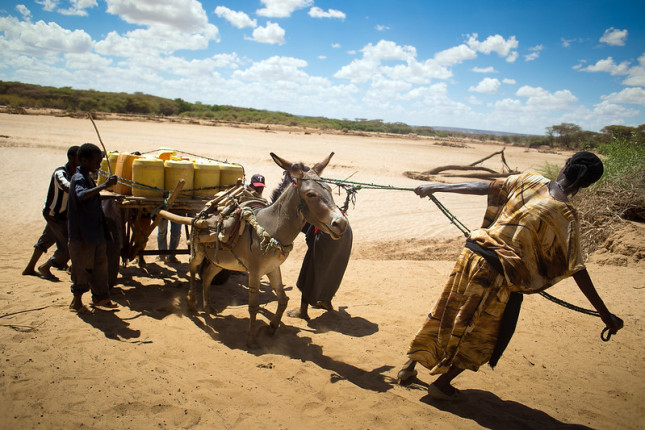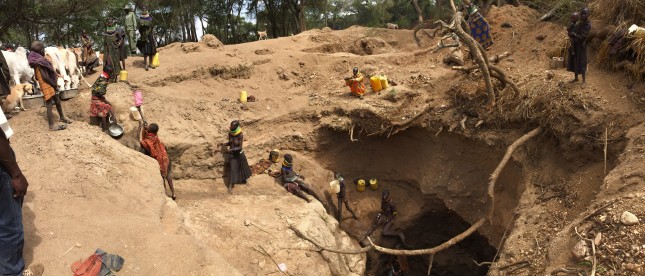-
From Rhetoric to Response: Addressing Climate Security with International Development
June 14, 2021 By Daniel Abrahams
Over the past decade, our understanding of how climate change affects conflict and security has advanced considerably. Yet, how to best address the overlapping challenges of climate change, conflict, and human security remains an open question. In an article published in World Development, I address this topic by examining how climate security discourses inform development policy and, in turn, how the structures of development enable or constrain institutional capacity to address climate security. This research identifies not only the unique barriers the development sector must overcome, but also the ways in which the most common framings of climate change (i.e., as a threat multiplier) limit the scope for policy and programming.
I conducted this research in partnership with the international development and humanitarian NGO, Mercy Corps, focusing on programming they implemented in Karamoja, Uganda. As I describe in a previous post, Karamoja is recovering from years of intense armed violence. It is also facing a new set of localized security risks associated with increasing pressure on its natural resources. These pressures include contestation over land rights and land access, region-wide changes in socioeconomic structures, and increasingly extreme and unpredictable climatic patterns. Mercy Corps’ programming sought to address these challenges through resilience and peacebuilding programs.
Barriers to addressing the overlapping challenges of climate change, conflict, and human security
The idea for this research derived from a study I conducted on the U.S. policy community’s approach to climate security. Throughout data collection, research participants—a diverse set of U.S. policy actors representing multiple sectors—consistently described the need for programming that addresses climate change’s role as a threat multiplier, but struggled to articulate the specifics of potential interventions. That is, there was a gulf between the demand for development programming that addresses the security risks of climate change and clarity on what such programming might entail. This research explicitly examined that gulf. I drew upon data sources from all stages of the program cycle to trace how notions of climate security are ultimately integrated into ground-level programming. I identified the three key overarching barriers for the development sector’s ability to address the joint challenges of climate change, conflict, and human security: 1) the spatial complexity of climate security; 2) competing temporal framings of climate change and security; and 3) logistics, security, and program governance.
Spatial: For those implementing development programming, the relationship between climate change impacts and security outcomes necessitates considering multiple, often non-contiguous geographic locations. For example, in Karamoja, survey respondents consistently noted higher rates of conflict and theft during the dry season in areas near Uganda’s greenbelt as well as near the Kenya-Uganda border. In both areas, the pathway that led to conflict involved resource imbalances. Those facing the most severe climate change impacts would seek access to key resources (i.e., pasture and water) in other geographies, even as the geographies also faced environmental shocks. This dynamic is consistent with the broader climate security literature, which demonstrates that climate security impacts involve stakeholders and processes across wide-ranging spatial scales connected by mediating factors such as relative resource scarcity and abundance, human mobility and movement, and economic markets.
In essence, for development practitioners—especially those working at the community-scale—addressing climate security likely requires accounting for climatic factors in place A, conflict outcomes in place B, and occasionally socioeconomic factors in place C. This spatial dynamic has a number of consequences for program implementation: it challenges development practitioners’ ability to understand how climate change affects conflict, complicates how to prioritize sites of program implementation, and creates challenges for program evaluation.
Temporal: The distinct temporal nature of conflict and other forms of acute crises (immediate-term) and climate change/variability (longer-term) reinforces the challenges defined by the issue’s spatiality and can create new complications. This manifests in two key ways: First, there is often a lag between the impacts of climate change and the related conflict outcomes, which challenges understandings of climate security pathways and, therefore, interventions. Second, elevating climate change as a priority in the context of an acute crisis is difficult at all stages of program design and implementation, from gathering institutional buy-in at the policy level to securing participation from communities. Simply put, it is difficult to make climate change a priority relative to the need to respond to, or otherwise mitigate, conflict and acute crises. In Karamoja, this was the case even when climate change was seen as a proximate driver of insecurity.
Logistics, Security, and Program Governance: An often overlooked, but important consideration for addressing climate security is the challenges specific to implementing development in fragile and conflict-affected places. Poor infrastructure, safety risks for implementing staff, and the high financial costs of working in conflict zones feed directly into the spatial and temporal challenges described above. For example, senior staff from multiple NGOs expressed their concerns that climate change was exacerbating conflict related challenges in places such as Somalia and Yemen, but expressed low confidence in their ability to implement in these places, in large part because of the complications of security and access. All of these concerns, costs, and considerations raise important questions about where development agencies can effectively and safely operate when addressing climate security concerns.
Overcoming barriers and identifying paths forward
Despite a discourse which emphasizes the ways in which climate change worsens or exacerbates conflict and security outcomes, an explicit reckoning with the contextual, indirect nature of climate security can open up productive areas for intervention. Take, for example, cooperation over natural resource access between Dodoth and Turkana community members, two groups with longstanding rivalries. In the photo below, taken in northern Karamoja near the Kenya border in an area called Loyoro, you can see hand-dug holes. These holes, which were scattered throughout the area, are dug every dry season as a means to access water for cattle in the extended dry season. Although the land is in Uganda and belongs to the Dodoth, the women extracting the water are from Turkana and reside largely in western Kenya. Despite the fact that the groups are still prone to localized conflicts and inflammatory rhetoric, the cattle were watered and Dodoth and Turkana community members wandered past without incident.

These outcomes were built on a multitude of peacebuilding efforts, including a resource sharing agreement, which Mercy Corps helped develop. Through the agreement, specific rules were established by local governance committees that enable the Turkana to essentially rent the land from the Dodoth in order to increase their resilience to the increasingly unpredictable rain patterns and lengthening annual dry season. At the same time, the shared process and mutually agreeable resource access helped to reduce conflict between the groups.
The barriers identified in this research help explain the disparity between demand for development programming targeting climate security and the lack of tangible efforts. Paradoxically, ground-level efforts that seek to address climate security are challenged by the very nature of the issue. Program design must align with the spatial, temporal, and logistical realities that govern interventions, otherwise they risk being ineffectual. In addition, our responses to climate security must progress beyond the “threat multiplier” framing, which has played a critical role in communicating the risks, but is limiting in its ability to inform responses.
By broadening our approach to the myriad ways climate change, conflict, and human security align, agencies are more likely to break through—or at least circumvent—the spatial, temporal, and logistical barriers that challenge development response. That includes identifying opportunities for peacebuilding, considering the conflict risks of adaptation, and addressing conflict drivers of climate change vulnerability. In taking this broader approach, development practitioners are likely to find clearer entry points and opportunities for mitigating the security risks posed by climate change.
Daniel Abrahams, PhD, is an American Association for the Academy of Sciences (AAAS) Fellow serving as the Technical Lead and Field Advisor on the Natural Climate Solutions division at USAID. Daniel Abrahams was not at USAID when the research discussed in this article was conducted. The views and opinions expressed in this paper are those of the authors and not necessarily the views and opinions of the United States Agency for International Development.
Sources: Climatic Change Journal, Conflict, Security & Development Journal, Current Climate Change Reports, Global Environmental Change, International Committee of the Red Cross, International Journal of Disaster Risk Reduction, Journal of Peace Research, Mercy Corps, New America, New Security Beat, Political Geography Journal, World Development Journal
Lede Photo Credit: Drought in Kenya’s Ewaso Ngiro river basin, courtesy of Denis Onyodi/KRCS.
 A Publication of the Stimson Center.
A Publication of the Stimson Center.




